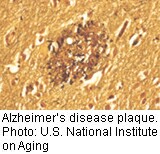
THURSDAY, May 20 (HealthDay News) — Researchers say a kind of protein that clogs the brain in Alzheimer’s disease also accumulates in the eyes of Down syndrome patients and causes cataracts.
The finding is leading the researchers to develop an eye test for early signs of Alzheimer’s in both disorders.
“People with Down syndrome develop symptoms of Alzheimer’s-type dementia often by the age of 30,” said study co-author Dr. Lee E. Goldstein, associate professor at Boston University School of Medicine, in a statement. “This is because they have an extra copy of a key Alzheimer’s gene that leads to increased amyloid-beta accumulation in the brain. We discovered that this same protein starts to accumulate very early in the lens of the eye, even in children.”
“The results are striking,” added Dr. David G. Hunter, ophthalmologist-in-chief at Children’s Hospital Boston and vice chairman of the department of ophthalmology at Harvard Medical School. “We have known that these cataracts are prevalent in people with Down syndrome and are sometimes seen at birth, but we never knew how they were related to the disorder. Now we know. These distinctive cataracts appear only in people with advanced Alzheimer’s disease and much earlier in Down syndrome.”
Goldstein said the team is developing an eye scanner to measure amyloid-beta, the protein in question, in the lens. “This approach may provide a way for early detection and monitoring of related pathology in the brain. Effective treatments for the brain disease in Down syndrome and Alzheimer’s disease are on the horizon, and early detection is the key for successful intervention.”
The findings were reported in the May 20 issue of the journal PLoS One and presented at the recent meeting of the Association for Research in Vision and Ophthalmology in Fort Lauderdale.
More information
For more about Alzheimer’s disease, see the U.S. National Library of Medicine.

